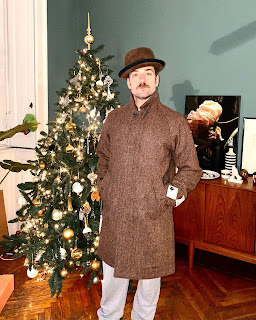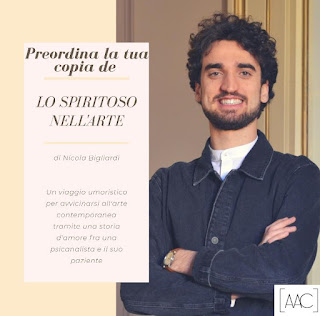Intervista a Francesco Dolfo: paralleli artistici tramite scatti fotografici [IT&EN]
*L'INTERVISTA E' UN'ESCLUSIVA DI CICCHETTI D'ARTE*
1- Tra i luoghi in cui lei ha lavorato, quale l’ha colpita maggiormente e perché?
Sono sempre affascinato dalla gentilezza delle persone che il più delle volte si riflette nel calore/ accoglienza dei luoghi. Mi risulta difficile dirne uno, in genere se decido di fare delle foto è perché c’è una predisposizione e delle buone intenzioni
1- Considering the places where you have worked, which one impressed you the most and why?
I’ve always been fascinated by the kindness of people that most of the times was a reflection of the warmth and hospitality of the places. It is difficult to me to just chose one, in general if I decide to
shoot somewhere is because there are good predispositions and intentions.
2- Quando deve realizzare uno scatto, da quale elemento inizia la composizione e come si
sviluppa?
Osservazione//Studio/Click
2- When you have to realize a photo-shoot, from which element do you start your compositions, and
how does it develop?
Observation\Study\Click
3- Il cuore del suo progetto flow(ers) è l'atmosfera sospesa e la volontà del fiore di emergere dalla
penombra e brillare: cosa le ha ispirato questi scatti?
I quadri del Caravaggio, Irving Penn, il lockdown passato in casa, il fatto che mi piace fotografare i fiori o gli oggetti in generali, cercare di rendere espressivo qualcosa che non lo è, la fragilità/forza della natura
3- The heart of your project flow(ers) is the suspended atmosphere and the intention of the flower to emerge from the semidarkness and shine: what was the inspiration?
Caravaggio’s paintings, Irving Peen, the lockdown spent at home, the fact that I like to photograph flowers or objects in general, trying to make espressive something that it is not, the fragility\strenght of nature
4- Che rapporto hanno secondo lei la fotografia, il design e le 3 grandi arti (pittura, scultura,
architettura)?
Domanda troppo complessa.
Un tempo eravamo più accademici, nel senso che un pittore era un pittore, uno scultore scolpiva,
poi con l’ avvento del Design industriale ha preso piede una certa interdisciplinarietà, ma già
Leonardo da Vinci era multitasking. Al giorno d’ oggi basta scrivere Astronauta sulla tua
descrizione di instagram e sei un astronauta. W lo spazio.
4- What kind of relation have to you photograph, design, and the three big arts (painting, sculpture, architecture)?
This is a too complex question. Once upon a time we were more academic, in the sense that a painter was a painter, a sculptor was a sculptor, Leonardo da Vince was multi-tasking. Today, you just need to write ‘astronaut’ in your Instagram’s bio and you become one.
5- Che tipologia di fiori sceglie, e perché?
Sono democratico o cerco di esserlo, una margherita può essere bella tanto quanto un giglio, una rosa può essere banale, un fiore di campo può essere eccezionale.
Ho avuto un crash con i papaveri perché sono fragili per natura e soprattutto perché durano poco, sono effimeri, e per questo mi piacciono. Appena si aprono sfioriscono e questo mi piace perché mi trasmettono il senso della trasformazione.
5- What kind of flowers do you choose and why?
I am democratic or at least I try to be, a daisy can be as beautiful as a lily, a rose can be banal,
wildflower can be exceptional. I had a crush towards poppies because they are frail by nature and
I like this because to me they transmit the sense of transformation.
6- Da dove nasce questa sua attrazione verso le nature morte?
La prima fotografia ad essere stata “bloccata” su un supporto è stata prodotta da Niépce, e
rappresentava uno scorcio dalla finestra di casa sua a Grasse. Poi sempre lo stesso autore ( pare) ha realizzato uno still life, una tavola con dei piatti sopra, che per certi versi ricorda molto Morandi, che associo molto a Ghirri. Per me scattare nature morte è un viaggio che parte dall’origine della fotografia e mi porta ogni volta in un posto diverso.
rappresentava uno scorcio dalla finestra di casa sua a Grasse. Poi sempre lo stesso autore ( pare) ha realizzato uno still life, una tavola con dei piatti sopra, che per certi versi ricorda molto Morandi, che associo molto a Ghirri. Per me scattare nature morte è un viaggio che parte dall’origine della fotografia e mi porta ogni volta in un posto diverso.
6- Where does it come from your attraction towards still lives?
The first ever photography ever ‘captured’ on a support was made by Niépce, and it represented a glimpse of the window located in his home in Grasse. It also seems that the same author made a still-life, a panel with some plates on, that it reminds Morandi in some ways, that I associate a lot to Ghirri. To me to take pictures of still-lives is a journey that starts from the origins of photography and that leads me everywhere in a different place.
7- Quando deve realizzare un ritratto, che processo creativo attua e cosa spera ottenere dallo
scatto?
Il processo creativo varia sempre a seconda delle situazioni, ma è sempre finalizzato ad ottenere un’ immagine semplice e naturale. Come se fosse un autoritratto.
7- When you have to take a photography, what kind of creative process you put into effect and what to do you expect to obtain from the shoot?
The creative process always change based on the situations, but it is always finalized towards obtaining a simple and natural image. Like it was a self-portrait.
8- Vi è un oggetto di design da lei creato a cui è particolarmente legato, e perché?
Non creo oggetti, ma mi piace raccogliere cose per strada da utilizzare per le mie ricerche: una testa di uccello, un ramo secco, un bullone arrugginito, un fil di ferro aggrovigliato e tinto di bianco....
8- Is there a design object you have created that you are particularly attached to, and why?
I don’t create objects, but I like to collect objects from the street to use for my researches: a bird’s head, a deadwood, a rusty bolt, a tangled iron-wire painted white..
9- Vi sono fotografi e/o designers presenti/passati che la ispirano?
Devo dire che i miei preferiti stanno scomparendo tutti purtroppo, ma ho fiducia nel futuro e nelle nuove generazioni
9- Are there present/past photographers and/or designers who inspire you?
I must say that my favorites are all disappearing unfortunately, but I have faith in the future and in
the new generations.















Comments
Post a Comment